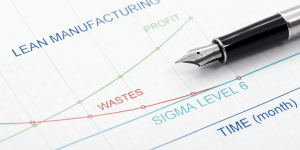Welcome, readers! Today’s blog post is all about implementing Kaizen at the workplace. If you’re not familiar with the term, Kaizen is a Japanese philosophy that focuses on continuous improvement. The core principles of Kaizen are to eliminate waste, improve efficiency, and involve everyone in the process. In this article, we’ll explore the Kaizen principles, tools, and techniques you can use to implement Kaizen at your workplace. We’ll also discuss how Kaizen fits into the larger context of Lean Management. Whether you’re a business owner, manager, or employee, this article will provide you with valuable insights on how to improve your workplace processes and achieve better results. Let’s dive right in!
What is Kaizen?
Kaizen is a Japanese term that means “continuous improvement.” It is a philosophy that focuses on constantly making small, incremental changes to improve processes, systems, and products. Kaizen is not just a one-time event or a project, but rather a way of life that encourages ongoing improvement and innovation. The concept of Kaizen is based on the idea that small improvements can add up to significant gains over time. By constantly seeking ways to improve, organizations can become more efficient, effective, and competitive in their industries.
Kaizen involves everyone in an organization, from top-level management to frontline employees, who are encouraged to identify areas for improvement and implement changes. An effective Kaizen program requires a culture of continuous improvement, where employees are empowered to make suggestions and take ownership of the improvement process. This requires open communication, collaboration, and a willingness to learn from mistakes. The goal is to create a workplace where everyone is invested in making the organization better. Incorporating Kaizen principles into an organization can lead to increased productivity, higher quality products and services, and happier employees.
By focusing on continuous improvement, organizations can stay ahead of the curve and remain competitive in an ever-changing business landscape.
Kaizen Principles
Kaizen is a Japanese term that translates to “continuous improvement.” It is a philosophy that focuses on making small, incremental improvements in processes and systems to achieve greater efficiency and productivity. The Kaizen approach involves everyone in the workplace, from senior management to frontline employees, in identifying and implementing improvements. There are several key principles of Kaizen that are essential to its success:
1. Focus on Process Kaizen is a process-focused approach that emphasizes the importance of understanding and improving processes. It involves breaking down processes into smaller, more manageable steps and identifying areas where improvements can be made. By focusing on processes, rather than on individual people or departments, Kaizen helps to create a culture of continuous improvement.
2. Eliminate Waste One of the key goals of Kaizen is to eliminate waste in all its forms. This includes not only physical waste, such as excess materials or inventory but also wasted time and effort. By identifying and eliminating waste, organizations can become more efficient and productive.
3. Empower Employees Kaizen relies on the active participation of all employees in the workplace. It is essential to empower employees and encourage them to take ownership of the improvement process. By involving employees in the process, organizations can tap into their expertise and creativity, leading to more effective solutions.
4. Focus on Continuous Improvement Kaizen is a continuous improvement process that never ends. There is always room for improvement, and organizations that embrace this philosophy are more likely to stay competitive and adapt to changing market conditions.
5. Use Data and Metrics To measure the success of Kaizen initiatives, it is essential to use data and metrics. By tracking key performance indicators and regularly reviewing progress, organizations can identify areas where improvements have been made and where further improvements are needed. In summary, the principles of Kaizen are focused on improving processes, eliminating waste, empowering employees, focusing on continuous improvement, and using data and metrics to measure success.
By embracing these principles, organizations can create a culture of continuous improvement that leads to greater efficiency and productivity.
Kaizen Tools and Techniques
Kaizen is a Japanese term that means continuous improvement. It is a philosophy that focuses on making small, incremental changes that lead to significant improvements over time. Kaizen tools and techniques are designed to help organizations implement this philosophy and achieve ongoing improvement. Here are some of the most effective tools and techniques for implementing Kaizen in the workplace:
1. Gemba Walks: This is a technique that involves walking around the workplace to observe and identify areas that need improvement. It is an effective way to identify waste, inefficiencies, and other problems that can be eliminated or improved.
2. Value Stream Mapping: This is a process of mapping out the steps involved in a specific process or service. It helps to identify areas of waste and inefficiency, and it provides a visual representation of the process that can be used to identify improvement opportunities.
3. 5S: This is a technique that involves organizing the workplace for efficiency and productivity. The 5S’s stand for Sort, Set in Order, Shine, Standardize, and Sustain. This technique helps to eliminate waste, reduce errors, and improve overall productivity.
4. Kanban: This is a visual management tool that is used to manage inventory levels and workflow. It helps to ensure that materials are available when needed, and it helps to prevent overproduction and waste.
5. Root Cause Analysis: This is a problem-solving technique that helps to identify the underlying causes of a problem. It involves asking “why” multiple times to get to the root cause of the problem. Once the root cause is identified, solutions can be developed to prevent the problem from recurring.
By implementing these Kaizen tools and techniques, organizations can achieve ongoing improvement and increased efficiency in the workplace.
Kaizen in Lean Management
Kaizen is one of the core principles of Lean methodology. It’s a Japanese term that means “continuous improvement.” In other words, it’s a process of making small changes and improvements every day to achieve a better outcome in the long run. Kaizen is all about empowering employees to identify areas for improvement and to take action to make things better. One of the key benefits of Kaizen is that it can help to create a culture of continuous improvement within an organization.
When employees are encouraged to think critically about their work, and to look for ways to improve it, they become more engaged and invested in their jobs. This can lead to increased job satisfaction, better morale, and ultimately, better business results. Kaizen is also a highly collaborative process. It involves everyone in the organization, from the CEO to the front-line workers, working together to identify opportunities for improvement and to implement changes.
This collaborative approach helps to break down silos and encourages cross-functional teams to work together towards a common goal. To implement Kaizen in your workplace, it’s important to start small. Identify a specific area where you think there is room for improvement, and then work with your team to come up with a plan to make things better. This could involve changing a process, adjusting a workflow, or even just reorganizing a workspace. Once you’ve implemented your first Kaizen improvement, it’s important to measure the results. This will help you to understand the impact that your changes have had and will allow you to make further improvements in the future.
In conclusion, Kaizen is a powerful tool for organizations looking to improve their processes and create a culture of continuous improvement. By empowering employees to identify areas for improvement and by working collaboratively to make changes, organizations can achieve better results and create a more engaged workforce.
Conclusion
In conclusion, implementing Kaizen at the workplace can bring significant improvements to your organization. By understanding the principles of Kaizen, you can focus on continuous improvement and make incremental changes that can have a big impact over time. Using Kaizen tools and techniques, you can identify problem areas and make improvements that will increase efficiency and productivity.
By integrating Kaizen into your Lean management strategy, you can create a culture of continuous improvement that empowers employees to identify and solve problems on their own. Remember, implementing Kaizen is a long-term process that requires commitment, discipline, and patience. But with the right mindset and approach, you can achieve great results and take your organization to the next level.












